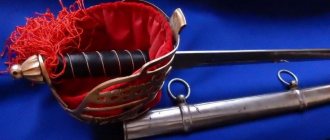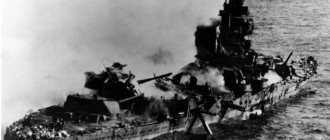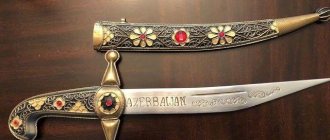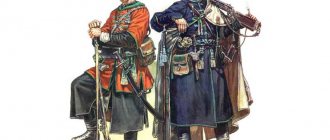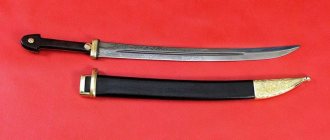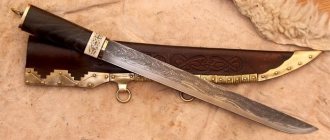History of the Kama knife
Between the 17th and 19th centuries, kama became widespread in the Middle East. And already in the 18th-19th centuries, a dagger of this shape became popular in the Caucasus. This blade was used as a bladed weapon and as an improvised tool in household affairs.
In Ossetia, Kabarda, Dagestan, Ossetia and Adygea, the dagger was worn from a very early age.
After the Caucasian War of 1817-1864, only Caucasians who joined the Russian army were allowed to use checkers.
This was accompanied by the fact that in the second half of the 19th century, according to researchers, the peak of production of Caucasian daggers came. They were paired with a saber, and sometimes even replaced it. Cossacks living in the border areas actively adopted the weapons of their opponents.
There is an opinion that the history of the dagger is closely connected with the gladius sword, which was famous in Ancient Rome. And Caucasian warriors began to be associated with the kama dagger. And in the 20th century, the dagger became a mandatory attribute of the Cossacks.
History of Cossack weapons
In various museums there are photographs depicting Cossack detachments. Every fighter had to have a bladed weapon. There were always 2 daggers at hand. The popular Plastun knife is known only from legends and songs.
Versions of occurrence
A plastun knife was considered a reward.
According to legend, the Don and Kuban Cossacks did not all have guns. They were awarded to those who were distinguished by special feats.
Also, the Cossack’s dagger showed his high material status.
The modern version says that they were made from broken pieces of checkers. They were used before purchasing a new one. Homemade weapons were simply thrown away when new ones appeared.
Who are Plastuns?
Plastuns are Cossacks without knives. In the ordinary imagination, they are necessarily on horses. In this case, the image of a walking Cossack who was on duty:
- exploration;
- watchdog
They terrified their enemies. In the most difficult conditions, they lay in a layer and merged with the terrain for observation.
In the Old Slavic language it means “to crawl.” The history of this military unit dates back to the 16th century. They were doing border tracking:
- Turks;
- Tatars;
- Poles.
According to official data, they were accepted into the civil service during the resettlement of the Cossacks to the Caucasus in 1787. This was due to:
- merits in the Russian-Turkish War;
- personal request;
- the need to protect borders.
Cossack knife.
Description of the dagger
A straight combat dagger is called a kama. The blades are parallel to each other. Closer to the edge they narrow and become pointed. In the middle of the blade there is a protrusion, a kind of stiffening rib. There are valleys on the sides of it, they reduce the weight of the structure.
But some products differed from the standard look. They had a different shape, for example, two stiffening ribs and two or three fullers. There could also be several stiffening ribs and valleys located between them. Both blades of the dagger are sharpened equally.
According to some experts, the cutting edge was sharpened to a razor sharpness. But this is absolutely unnecessary; the entire design of the product indicates that they need to prick, not cut. The size of the dagger affects the chopping properties of the product.
But it is possible to achieve the ability to deliver various blows while maintaining the ideal piercing properties of the dagger. The product sizes are as follows:
- a small blade 25-30 cm long - it is impossible for them to deliver chopping blows;
- average product 33-40 cm - ideal size for all strikes;
- a large blade 45-60 cm - it is very difficult to deliver a cutting blow.
Caucasian kama dagger.
Kama
Kama is a straight combat dagger. Its blades are parallel to each other. Towards the edge they narrow sharply and become a point. In the middle there is a kind of stiffening rib, on the sides of it there are two grooves - valleys, designed to reduce the total weight of the product. However, this is only a standard shape; many specimens had other shapes, such as two stiffeners and three fullers, three stiffeners and four fullers, or one stiffener and one off-center fuller.
Both blades are equally sharpened. The main purpose of this type of bladed weapon is to stab, so its cutting properties are somewhat exaggerated by those who say that they are razor-sharp. And attempts by modern craftsmen to correct “mistakes” and sharpen the blade only lead to damage to the weapon.
The dimensions of the Caucasian dagger affect its cutting and chopping properties. While maintaining ideal piercing properties, the blades can be more or less adapted to other types of blows.
- Small 25-30 cm - not intended for slashing.
- The average 33-40 cm is the most versatile model, which can equally be used for both cutting and chopping blows.
- Large 45-60 cm - not intended for cutting blows.
In addition, each nation has its own characteristics of the blades of Caucasian daggers:
- Azerbaijani - had a rich ornament, both on the weapon itself and on the handle and sheath. These are arches, curlicues of branches, stylized leaves.
- Armenian ones are distinguished by an elongated head of the handle.
- Georgian ones are usually wider and shorter. These are the most powerful of the Caucasian blades.
- Dagestan ones are considered the best. They, like the Armenian ones, have an elongated handle head. They are elegant and well made.
Shape and dimensions
The edge of the blade is tetrahedral and elongated, the blades are sharpened equally. Basically, daggers of this type are intended for stabbing, but some could also cut.
The fullers on the blade helped reduce the weight of the product, give it greater strength and decorated it.
Basically, daggers were made to order. It could be designed in accordance with the traditions of the area. A dagger measuring 30-50 cm was considered average. It was rare, but larger sizes were also found. Such an example would be the quaddara.
Externally, the dagger was similar to a sword and its length reached 90 cm. It could replace a checker or saber. Depending on the region of the Caucasus, products could be of different sizes:
Dagestan and Armenia
In Dagestan and Armenia, the dimensions of the dagger were the largest and reached a length of 45-55 cm, and the width of the blade was 4.5-5 cm.
Kabardians, Circassians and Georgians
Among the Kabardians, Circassians and Georgians, the products were 33-35 cm, with a blade width of 3-3.2 cm.
Rostov region
In the Rostov region, daggers were the smallest, 25-30 cm and 3 cm wide.
Instances of the Tavlinsky type served as bladed weapons with an elongated blade. Their length reached 75 cm. At one time, the dagger of the Kuban Cossack Army appeared in Russia. Mostly he was medium in size.
But some Cossacks ordered products of larger sizes. They were able to replace the checker. The products differed in the place of production, shape and size.
Modern replicas of the kama dagger.
MAKSIMOV.SU
KKV dagger
produced by PP Kizlyar LLC
Link
to the official website of the Kizlyar online store The topic of Cossack edged weapons is huge and very difficult.
There are recognized experts in this field, their works have been published both in excellent books and on the Internet, so I will not meddle in their diocese. I will only touch on the name of the Kizlyar dagger, which will be discussed in this material.
Fullers on the blade
So,
Based on information from open sources, KKV is an abbreviation that should be read as Kuban Cossack Army. Daggers arr. 1904 had etching on the heel.
Moreover, the stigma
could be either KKV or TKV.
I found this interesting description of the KKV dagger online: “The blade is steel, straight, two-edged, with four narrow fullers. Brand on the blade
Characteristic sign
- the abbreviation on the heel of the blade “KKV” (Kuban Cossack Army) or “TKV” (Terek Cossack Army). The hilt consists only of a handle.
Handle
made of red gold, figured. The top and bottom buttons are silver. Wooden scabbard covered with leather. The metal device consists of a mouth with a strap bracket and a tip with a ball.”
The mouth of the sheath,
the contact part (clamp) of the guard
The most decorated part
of the dagger and scabbard
Based on the available information,
the KKV mark has nothing to do with the name of the dagger, it is only a designation of the purpose of the weapon - for which army. The Kizlyar people made the right marketing decision by launching the production of replicas (exact working copies) of historical edged weapons.
Genuine
surviving Caucasian and Cossack daggers are quite rare on sale and can have a very high price. For 2016, the cost of an antique dagger mod. 1904 fluctuated between 3.5-5 thousand dollars (with the expertise of the Ministry of Culture of the Russian Federation), you can calculate the ruble equivalent yourself. Such a high price is due to the popularity of this bladed weapon, and there are no more of them available.
Dagger "KKV"
against the backdrop of wooded mountains of the Black Sea coast of the Caucasus
Dagger handle design
Handle detailing
Therefore, Kizlyar copies
at prices starting from 6 thousand rubles in cupronickel and copper, they are tempting items for collecting and original gifts. For about 20 thousand rubles you can buy a dagger in a silver setting.
Anyway,
the price tag turns out to be quite acceptable for those who want to have a historical edged weapon, but cannot afford to buy the original. Now let's see what the Kizlyar copy of the historical dagger mod. 1904.
Another angle of the dagger
from both sides, hilt
Blade,
scabbard tip
On photos
you see the “KKV” dagger in nickel silver design. The total length of the dagger is 475 mm, while the length of the blade is 330 mm. The thickness of the blade butt is 5.6 mm. The blade is made of corrosion-resistant steel 50Х14МФ and has fullers. Wedge sharpening. The blade has a high-quality and artistically interesting double-sided engraving on the blade.
Dagger hilt
made of Caucasian walnut, guard and other elements of the device are made of cupronickel. The handle dies are riveted to the blade tang. The scabbard has a wooden body covered with genuine leather with a nickel silver tip and mouth. You can buy a dagger upon presentation of a permit to store and carry hunting weapons.
KKV dagger in hands
Different grip
of the dagger
Total: KKV dagger
is a high-quality copy of a Cossack dagger mod. 1904, with various design options and at an affordable price. An excellent thing to give as a gift to a man; it looks good on the wall, either in a selected display or on its own.
Briefly speaking,
An interesting thing for the interior, admiring and “holding in your hands.” It may well become the reason for the emergence of interest in the history of Russian and Caucasian weapons.
Dagger detailing
And once again
a general view of “KKV”
Good luck on your hunting trail!
Handles and scabbards for Caucasian daggers
The handles were made of walrus bone or horn. The mounting of a handle made of solid horn or bone was done with rivets to the shank of the blade for reliability. The overhead handle was made from plates of the same material. They were attached to the shank on both sides and connected with washers.
Cheren was decorated with the help of metal elements. You could also often find a metal handle. They could be composed of several elements, or they could also be all-metal. To prevent the blade from dulling, the sheath was made of wood.
The outside was covered with leather, which was also decorated with metal elements. The sheath was attached to the belt on both sides. This was convenient for right-handed and left-handed people, and wealthy people could carry two daggers with them. This demonstrated the wealth of the owner of the products.
Handle material
As already mentioned, the handle was made of horn, bone or metal. It had a wide base and ended with a large arch-like pommel. The handle material was riveted to the tang, and there was no guard or stop at all.
Decoration
Handles and blades were often engraved. The masters put their mark. The origin of the master could be determined by the pattern. The scabbard had various original ornaments.
Examples of kama dagger hilts.
Ethnic differences of the Kama knife
The kama dagger has always had features depending on the region of production. For example, the Azerbaijani blade has an ornament. The decoration could be of a plant nature or have geometric shapes. We also used a slotted ornament:
- Armenian kama had a top in the form of a typical eastern arch. Decoration in the form of tulips was considered very popular. They were placed on the hilt and sheath. Gold and silver notching were used at the same time;
- Georgian kama has a wide and short blade. The top of the handle is made in the shape of flower petals. The blade was decorated in the middle part with applied welding plates. And the heel could have figured through slots. The finishing of the handle and sheath made of silver could be made with floral patterns;
- Dagestan daggers have a very elongated handle head. They have little in common with Armenian products. But in the Caucasus, blades from Dagestan have always been considered the best. They have a second name - Kubachi daggers, after the name of the settlement where they are produced;
- The Lezgin dagger is one of the varieties of Dagestan products. Each golomen has one asymmetrically located fuller;
- the Khevsur product is similar to a Georgian dagger. But the parts of the handle and sheath are made of brass or iron. They have a simple ornament, which is made with copper notching;
- The Azerbaijani blade has a floral and geometric pattern. Also on the hilt and sheath are recycled elements of applied art.
Officer's dagger KKV
It is no secret that since the 19th century, Caucasian-type daggers have gained wide popularity in the ranks of the Russian imperial army. If at the very beginning the Cossacks used various products obtained in battle. Then in 1904 a decision was made to approve a specific dagger.
Historical reference
In 1904, the dagger was adopted for the lower ranks of the Cossack troops. Before the start of the First World War, almost all Cossacks were armed with just such daggers. But in the Cossack troops at the beginning of the 20th century, weapons made by Caucasian craftsmen were widely used.
It was distinguished by the great variety with which the Cossacks could go to work. The peculiarity of such instruments was that various designs and ornaments on the handles and sheaths were very widespread. Officers' items were decorated with silver.
Dagger of the Kuban Cossack Army.
A little about the manufacturer
Zlatoust arms factory.
The Zlatoust arms factory produced edged weapons for the needs of the Russian army and navy. The company was opened in 1815. Several wooden buildings were built on the banks of the Ai River, where the main departments of the factory were located.
It was not until 1839 that the first stone building was built.
The factory produced various military weapons, including: checkers, sabers, broadswords, swords, cutlasses, daggers, dirks, pikes and knives. By the beginning of the 20th century, the production of bladed weapons reached 42 thousand units per year.
The products produced by the factory were widely known not only in Russia, but also abroad. The weapon was presented at various exhibitions, where it occupied high places. The Zlatoust arms factory was one of the best industrial enterprises in Russia.
Description of the dagger
The blade was made of steel and was straight with two blades. It was made of two wide and two narrow valleys on both sides. At the base of the blade there are etched cartouches on the left side "Z.O.F." in a plant frame.
On the right side it is written - KKV, which meant Kuban Cossack Army. There is also a production date for the product. The classic Caucasian handle was made of horn. The linings are secured to the blade shank with three rivets.
They end in the form of spherical caps. At the base of the handle there is a nickel silver belt, it is decorated with engraving. The scabbard was made of wood and covered with leather. They were decorated with an engraved floral ornament consisting of curls.
KKV dagger.
The legendary edged weapon is the Caucasian dagger “Kama”.
“Be slow to take offense, be quick to retaliate”
According to the testimony of the Russian writer Bestuzhev-Marlinsky, who served as an officer in the Caucasus during the Caucasian War, this is exactly the inscription that graced the blade of the dagger of the Dagestan abrek Amalat Bek. This inscription best characterizes both the weapon on which it was inscribed and the mountaineers themselves who used these weapons.
Spirit of chivalry.
In the XVIII - 60s. XIX century The Caucasus remained one of the few regions of the world where chivalry was preserved as a social phenomenon, with all its inherent moral and ethical values, while in Europe and Russia it had long been the subject of legends and chivalric literary novels. For example, in Circassia, life was not regulated by state institutions and laws, but traditions and customs, the system of which was collectively called Adyghe khabze (Adyghe custom). It was in many ways similar to both the etiquette of Japanese samurai and the etiquette of medieval knights in Europe. This system, just like the Japanese, prescribed an outwardly calm enduring of suffering, contempt for death, unconditional submission to elders, extreme modesty and politeness, according to modern concepts reaching the point of absurdity. As for the respectful attitude towards a woman, in this regard, the Adyghe custom was closer to medieval European knightly etiquette.
| "Meeting at the spring." |
More terrible than death.
Neither material well-being nor high social origin in themselves provided the highlander with a significant social position. Its achievement was possible only under the condition of strict adherence to the principles of “Adyge khabze”, and their violation led, as the Adygs said, “to loss of face” (napetekh), which was considered worse than death. “Fear shame more than death,” said the Adyghe proverb. Thanks to such a concept as “nape” - face, conscience, honor, the Circassians had no prisons, no corporal punishment, no torture. This concept in itself was the strongest deterrent to any unworthy, criminal or antisocial actions.
| Tsakhurets (one of the nationalities of Dagestan) with a large kama dagger on his belt. Hood. M. Tilke. |
"The Law of Blood"
Another restraining principle within the framework of “Adyghe khabze” was the law of blood feud, according to which the highlander had to wash away the insult he had inflicted on himself with the blood of the offender. Otherwise, he also risked “losing face.” Therefore, the best Circassian knights, on the one hand, were very modest, respectful and polite people, strictly careful not to offend others with their actions, and on the other hand, they were warriors full of dignity, always ready to respond with lightning speed to a real insult with a blow. dagger. In general, this state of affairs was typical not only for the Circassians, but also for other peoples of the North Caucasus.
| "Reconciliation of bloodlines." According to the ancient tradition that existed among many Caucasian peoples, if a woman stood between the fighting men and threw her handkerchief, they had to immediately stop the fight, otherwise risking covering their names with indelible shame. |
A symbol of dignity.
At that time, Caucasian men wore a dagger constantly, starting from adolescence. It was used both as a weapon and as a household item for various household needs - cutting brushwood, slicing meat, etc. In addition, the dagger was an indispensable accessory to the costume of a man of any social stratum who had the right to bear arms. The highlander ate, drank, worked, had fun, always with a dagger on his belt and even when going to bed, he put it under his head. Therefore, he was always armed. Thus, it was the dagger that symbolized male dignity and the owner’s readiness to defend this dignity at any moment.
| Ossetian in full armor, with a large Caucasian kama dagger on his belt. In hand-to-hand combat, such a dagger could successfully replace a checker or saber. Photo of the second half of the 19th century. |
| Georgian shepherd boy. Photo from the beginning of the 20th century. From the photograph it is clear that the boy is very poor, nevertheless, on his belt, as an adult man, he wears a Caucasian dagger that is not at all for children. A dagger similar in shape is shown in the photo below under the name “Khevsur dagger” |
Grace and perfection.
Caucasian daggers Kama (kama) XVIII – XIX centuries. belong to the class of medium- and short-bladed piercing and cutting bladed weapons. For the most part, they all have a similar design of the same type - a straight, double-edged blade, the parallel blades of which smoothly taper towards the tip, and a handle with an expanded base, a narrow handle and a cap-shaped head. The diamond-shaped dagger blade ends in an elongated tetrahedral tip with high penetrating ability. As a rule, it is reinforced with a stiffening rib, or worked with fullers, the number of which ranges from one to four. The valleys on different sides of the blade can be located asymmetrically relative to each other. They make the blade decorative, increase its strength and, at the same time, reduce weight. Dagger handles are made of different materials - bone, horn, iron, silver. The metal handles are designed in the form of a case, which is placed on a wooden base, while the horn and bone handles are made solid or composite. The dagger sheath is wooden, covered with leather and equipped with a special loop for wearing on the belt in front. On the reverse side of the sheath there is a socket for a dagger knife, used for domestic purposes. The metal device of the scabbard usually consists of a mouth, a holder and a tip, but sometimes the scabbard is completely forged with metal, like the handle. The total length of Caucasian daggers ranges from 400-750 mm, the length of the blades is respectively 300-620 mm, and the width of the blades is 30-66 mm. In the XVIII - early XX centuries. the best Caucasian daggers were richly decorated with silver, niello and gilding and were highly valued for their versatility of use, elegance of design and perfection of execution far beyond the borders of the North Caucasus.
| An elegant Caucasian (Dagestan, or rather Lak) kama dagger in a silver frame, made in the Circassian style. Beginning of the 20th century. The blade is designed with an asymmetrical fuller. Silver, niello, wood, steel, leather. The total length is 51 cm. In the 18th - 19th centuries, the Circassians (Circassians) were trendsetters in the North Caucasus, including in the field of weapons production. Therefore, many Caucasian masters, even after the mass eviction of the Circassians from their historical homeland, continued to copy the Circassian style. |
| Turkish kama dagger of the late 19th - early 20th centuries. The blade is reinforced with a stiffening rib. Steel, wood, leather, copper, gilding, carving. The total length is 50 cm. A number of researchers associate the appearance of daggers of this type in Turkey with the name of Sultan Abdul Hamid II (1876-1909), who created the irregular Kurdish military cavalry formations “hamidiye” in 1890 (Turkish hamidiye, literally means “ belonging to Hamid"), armed and equipped according to the Circassian model and intended to patrol the borders of the Ottoman Empire. However, various sociocultural and economic contacts of the Ottoman Porte with the peoples of the North Caucasus (especially with the coastal Circassians and Abkhazians) existed long before the accession to the throne of Sultan Abdul Hamid II. This means that the kama dagger could have been borrowed by the Turks at an earlier period. |
| Arab kama dagger from the 19th century. The blade is fully worked and decorated with Arabic script in traditional Muslim style. Steel, wood, velvet, silver, bone, false grain, leather appliqués (imitating galloons?). According to some scientists, Caucasian kama daggers appeared in the Arab East along with migrants from the North Caucasus - the Muhajirs, after the end of the Caucasian War (1864). However, taking into account the close trade and sociocultural ties of Arab countries with the regions of the North Caucasus, which developed during the reign of the Mamluks in Egypt and Syria, it can be assumed that this happened much earlier. |
| Cossack officer's dagger (Tersk Cossack Army) of the early 20th century. The blade is worked with fullers. Master Guzun Guzunov. Steel, wood, silver, niello, gilding, filigree. The total length is 47 cm. The Terek and Kuban Cossacks borrowed many cultural elements from the Caucasus, clothing, weapons, the manner of saddling horses, methods of warfare and combat. |
| Cossack officer's dagger (Kuban Cossack Army) of the early 20th century. The blade is worked with fullers. Anosovsky damask steel, horn, leather, wood, silver, niello, notch. Total length 50 cm. |
| Russian kama dagger. Chrysostom, 1840. The blade is designed with an asymmetrical fuller. Anosovsky damask steel, horn, wood, velvet, silver, gilding, notching. In this sample, while maintaining a slightly modified Caucasian form of weapon, Russian motifs are already clearly visible in the ornamental design. With the beginning of the Caucasian War, fashion for Caucasian clothing and weapons arose in the high society of the Russian Empire. The Circassian coat, dagger and saber were worn by Russian officers and generals, Grand Dukes and even Emperors. According to their orders, the Zlatoust plant also produced richly decorated Caucasian daggers and sabers. |
| Circassian (Adyghe) nobles Muhajirs in Turkey. All with sabers and Caucasian kama daggers on their belts. Photo from the end of the 19th century. |
| Kurdish officers of the Hamidiye regiment, dressed and armed according to the Circassian model. Everyone (except one in the background, dressed in a Turkish uniform) has Caucasian kama daggers on their belts. Photo from the beginning of the 20th century. |
| Emperor Nicholas II in a Circassian coat, with a saber on his sword belt and a Caucasian kama dagger on his belt. |
| Grand Duke Mikhail Alexandrovich Romanov at the front, surrounded by generals. Photo from 1914. Everyone has Caucasian kama daggers on their belts. |
| Tsarist general, after the revolution of 1917 - Ukrainian military and political figure, hetman of Ukraine (from April 29 to December 14, 1918) P.P. Skoropadsky in a Circassian coat, with a Caucasian kama dagger and a saber on his belt. Photo from 1918. |
| General of the “White” Army A.G. Shkuro (Skin) in a Circassian coat, with a saber and a Caucasian kama dagger on his belt. Photo from 1919. |
| General of the “White” Army P.N. Wrangel in a Circassian coat, with a Caucasian kama dagger on his belt. Photo from 1920. |
| General of the “White” Army Ya. A. Slashchev-Krymsky in a Circassian coat, with a Caucasian kama dagger on his belt. Photo from 1920. |
| Future General of the Army, twice Hero of the Soviet Union, holder of six Orders of Lenin, the Order of the October Revolution, the Order of the Red Banner, the Orders of Suvorov and Kutuzov 1st degree, I.A. Pliev in a Circassian coat, with a Caucasian kama dagger, a pistol and a saber on his belt. Photo from 1926. |
| Cossacks of the 13th Kuban Cavalry Division at the front. August, 1942. The Cossack has a Caucasian kama dagger in the center of his belt. |
Ethnic characteristics.
Despite the similarity in design, the daggers of different Caucasian peoples also had certain differences. The Circassians had two main types of daggers: the small, narrow Kabardian and the short, wide Shapsug, which inflicted the most dangerous wounds. Dagestan, Georgian and Armenian daggers are on average larger than Circassian, Ossetian and Abkhazian ones. In particular, Tavlinsky (Tavlinians are one of the nationalities of Dagestan) daggers, which were quite widespread in the North Caucasus, reached a length of 750 mm and replaced long-bladed weapons such as sabers or sabers for ordinary warriors. In addition, in design, all these varieties differed from each other in their original national ornaments and decorations.
| A small Circassian (Adyghe) dagger of the “Kabardian” type. XIX century. Steel, wood, leather, silver, checkering. The narrow blade decorated with a notch is reinforced with a stiffening rib and is characterized by high penetrating ability. The total length is 43.5 cm. The mountain nobility armed themselves with daggers richly decorated with silver (in this case, the wooden scabbard and handle are completely bound in silver). As a rule, all these daggers are small in size, since their owners preferred to fight mounted ( |
Symbol of dignity
In the old days, Caucasian men carried a dagger almost constantly, starting from adolescence. The product was used as a combat and hunting item. But they could also solve various economic problems.
The kama dagger was an indispensable attribute of the national costume. The highlanders carried out all their tasks with a dagger in their belts, even when going to bed they placed it at the head of the bed. Thus, man was always armed. The dagger was a man's asset, and it could always be protected.
Grace and perfection
Caucasian kama daggers from the 18th-19th centuries belong to medium- and short-bladed edged weapons. Most products have a similar, uniform structure. The products have a straight and double-edged blade, the parallel blades of which smoothly taper towards the tip.
The handle was narrow with a wide base, the head of the pommel was shaped like a cap. The dagger's blade has a diamond-shaped cross-section; it ends with a tetrahedral tip, which has high penetrating ability.
There is a stiffening rib and the blade is worked with fullers, the number of which can be from 1 to 4. They can be located asymmetrically. The handle was made of various materials: horn, bone or metal. The sheath was made of wood and covered with leather.
On the back of the case there was a small dagger socket for a small knife, which was used for household needs. The length of the product was 400-750 mm, the blade accounted for 300-620 mm. The width of the blade was 30-66 mm.
Daggers of later production were richly decorated with silver, niello and gilding. The products have always been valued for their lethality, versatility of use, elegance of design and perfection of execution.
Caucasian kama dagger.
Modern replicas
Modern models are distinguished by geometry and balance. They can be used:
- instead of an axe;
- for cutting products;
- opening canned food.
All modern replicas have:
- the diamond-shaped cross-section of the blade is very similar to the dragoon sabers used by Russian officers. Has high penetrating ability when stabbing;
- maybe one or two dollars. Its function is decoration. Gives a more intimidating look;
- Heel reinforcement is used to improve appearance. An all-metal blade, based on hard steel, with such a heel is characterized by special reliability;
- The barrel-shaped handle has cross cuts. The curved butt makes it easier to apply chopping blows;
- The hard sheath has a loop for attaching to a belt and two straps that secure the sheath on the thigh.
Melee with a dagger
Kama dagger with scabbard.
The dagger was a terrible weapon in close combat; it could be used to chop, stab and cut. The technique of using the product consisted of deceptive movements and sudden lunges.
Russian participants in the Caucasian War spoke with admiration about the highlanders’ mastery of the blade.
There was an incident in 1858, when Caucasians fired rifle charges, 15 fighters jumped out of a defended stone tower and entered into hand-to-hand combat. There was a whole battalion of soldiers against them, but they were able to inflict numerous damage.
Finding themselves surrounded, desperate Caucasian abreks met their death with daggers in their hands. The dagger acted as an auxiliary weapon after the checker. There are even known cases when daggers were used as throwing weapons.
Duels with daggers
Duels with daggers sometimes took place among Caucasian aristocrats. In different regions of the Caucasus, the rules for conducting fights vary slightly. Among the Ossetians, the duel was held in a pre-designated area. The competitors were taken in different directions and blindfolded.
They were supposed to fight by sound alone. This equalized the chances of various fighters. The battle ended with the death of one of the opponents. The relatives of the deceased did not have the right to pursue the winner, and the dispute itself was considered settled.
In Chechnya and Dagestan the duel was conducted a little differently. A burka was spread on the ground, and the participant stood at its edges and the fight began. If one of the opponents left the burqa, the other participant had every right to stab him.
And if someone refused to take the fight, their horse and weapons could be taken away from them, which was comparable to shame. During the duel, the dagger was held with a direct grip and only slashing blows were applied. Piercing blows were prohibited. Death by stabbing was considered a deliberate murder.
Bebut
Bebut is a combat dagger with a curved blade. Only the curved side of it was sharpened sharply.
It is worth noting that it is quite rare among ancient weapons, unlike Kama. And those rare samples that can be analyzed belonged to the wealthy class. They were not used every day, but only as an attribute - a sign of wealth.
They became widespread during the First World War. The Russian army equipped artillerymen and machine gunners with them. The fact is that this type of bladed weapon had excellent cutting properties. It became a good replacement for the army cleaver, playing the role of a piercing weapon and an entrenching tool. After all, all artillery moved with the help of horses, and people had a constant need for a universal improvised device.
Despite the fact that, as a rule, Caucasian daggers were not sharpened like a razor, there are some very expensive, exclusive specimens that were truly super-quality. These weapons were made from welded damask steel or Damascus, which had special manufacturing technologies and were very durable and sharp. They were made only on individual orders by several craftsmen and had a very high cost.
The Caucasian peoples have many interesting traditions, customs and beliefs associated with blades. They have firmly entered into the culture and become an integral image of the Caucasian man.
